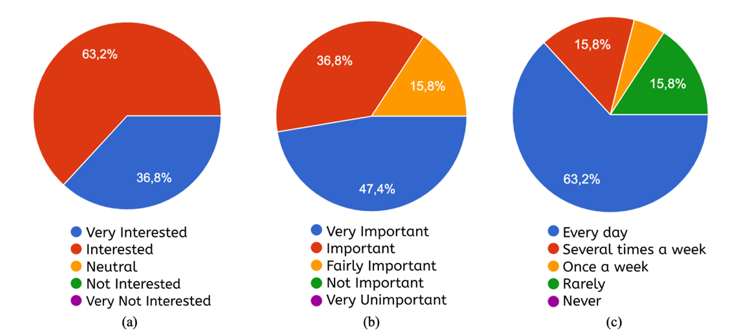An Exploratory Study of Augmented Reality for Teaching the Human Skeletal System at SMA Negeri 1 Suwawa
Main Article Content
Abstract
The study addresses the challenges students face in understanding the human skeletal system and the need for innovative learning media. The research aimed to analyze the needs of students and teachers while evaluating the potential of Augmented Reality (AR) cards as a teaching tool. Conducted at SMA Negeri 1 Suwawa, Gorontalo Regency, the study employed a descriptive qualitative approach with data collection through observations, interviews, and student needs surveys. Findings revealed a strong interest among teachers in adopting AR-based media and high enthusiasm among students, with 84.2% recognizing its importance and 94.2% owning compatible devices. The results highlight the necessity for print-based learning media integrated with AR technology to deliver three-dimensional and realistic visualizations. This approach effectively bridges theoretical concepts and interactive representations, addressing comprehension challenges. The study concludes that AR-integrated learning tools have significant potential to enhance engagement and understanding in biology education, emphasizing the importance of their development and implementation.
Article Details

This work is licensed under a Creative Commons Attribution-ShareAlike 4.0 International License.
Authors who publish with this journal agree to the following terms:
- Authors retain copyright and grant the journal right of first publication with the work simultaneously licensed under a Creative Commons Attribution-ShareAlike 4.0 International License that allows others to share the work with an acknowledgement of the work's authorship and initial publication in this journal.
-
Authors are able to enter into separate, additional contractual arrangements for the non-exclusive distribution of the journal's published version of the work (e.g., post it to an institutional repository or publish it in a book), with an acknowledgment of its initial publication in this journal.
- Authors are permitted and encouraged to post their work online (e.g., in institutional repositories or on their website) prior to and during the submission process, as it can lead to productive exchanges and earlier and greater citation of published work.

Bio Ilmi: Jurnal Pendidikan by http://jurnal.radenfatah.ac.id/index.php/bioilmi is licensed under a Creative Commons Attribution-ShareAlike 4.0 International License.
How to Cite
References
Alvionita, D., Murti, A. B., & Fakhrun Gani, A. R. (2021). Studi Literasi : Pelopor Pembelajaran Bermakna Menggunakan Teknologi Augmented Reality Pada Topik Lingkungan Di Era Merdeka Belajar. Bioilmi: Jurnal Pendidikan, 7(2), 73-82.
Astini, I. (2023). The effectiveness of teacher-centered strategies in improving students' focus and retention. Journal of Education and Learning, 12(3), 45-58.
Avila-Garzon, C., Gutiérrez, J. M., Zúñiga-Prieto, M. A., & Alcaraz, J. L. G. (2021). Augmented reality for the improvement of spatial abilities and academic performance in STEM education. Educational Technology Research and Development, 69(1), 85-104.
Azuma, R. T. (1997). A survey of augmented reality. Presence: Teleoperators and Virtual Environments, 6(4), 355-385.
Billinghurst, M. (2002). Augmented reality in education. New Horizons for Learning, 12(5), 1-7.
Damopolii, I., Firdaus, R., & Susilo, E. (2022). Dynamic and interactive teaching aids to enhance cognitive understanding in biology. Bioscience Education, 11(2), 15-25.
Fitria, S. (2023). Multimedia-based learning in complex biology topics: Enhancing student engagement. International Journal of Educational Development, 22(4), 133-141.
Hanzalova, L. (2019). Accessibility of biology for high school students: Barriers and challenges. European Journal of Education Studies, 6(11), 99-111.
Hermawan, D., Suhendar, S., & Rahmat, A. (2020). Bridging the gap between technology and teaching readiness: Challenges and strategies. Education and Information Technologies, 25(2), 243-257.
Hernawati, S., & Amin, M. (2017). Enhancing students' professional presentation skills through discussion-based learning. Journal of Educational Practice, 8(22), 145-154.
Jenkinson, J. (2018). Teaching cellular processes using innovative methods: A review. Science Education, 102(3), 367-390.
Kucuk, S., Kapakin, S., & Göktaş, Y. (2016). Learning anatomy via mobile augmented reality: Effects on achievement and cognitive load. Anatomical Sciences Education, 9(5), 411-421.
Lee, N., Owens, J., Francisco, G., & Pfeiffer, K. (2004). 3D animations as tools for anatomy education. Medical Education, 38(5), 509-516.
Malacinski, G. M., & Zell, P. (1996). Modern genetic analysis: Concepts and applications. Biology Education Quarterly, 9(2), 45-53.
Mauludin, R., Supriyono, & Rahman, M. (2017). The role of videos in biology learning: Improving students’ engagement. Journal of Biology Learning, 10(1), 12-21.
Mayer, R. E. (2005). Cognitive theory of multimedia learning. The Cambridge Handbook of Multimedia Learning, 31-48. Cambridge University Press.
Mitsuhashi, N., Fujita, H., & Imai, T. (2009). Visualization techniques in anatomy education. Journal of Medical Imaging, 22(3), 144-156.
Raja, R., & Nagasubramani, P. C. (2018). Impact of modern technology in education. Journal of Applied and Advanced Research, 3(1), 33-35.
Rifa’i, M. (2012). Systematic learning strategies in biology education. Journal of Educational Research, 15(4), 99-107.
Rotbain, Y., Marbach-Ad, G., & Stavy, R. (2006). Using computer animations to teach molecular biology concepts. Journal of Science Education and Technology, 15(3), 273-287.
Savery, J. R. (2006). Overview of problem-based learning: Definitions and distinctions. Interdisciplinary Journal of Problem-Based Learning, 1(1), 9-20.
Trilling, B., & Fadel, C. (2009). 21st century skills: Learning for life in our times. San Francisco: Jossey-Bass.
Wahyuni, R., Prasetyo, A., & Ramdani, R. (2021). Smartphones as educational tools: Impacts on interactive learning. Journal of Learning Innovations, 9(2), 56-68.
Yap, K., Neo, K. C., & Neo, M. (2021). AR in medical training: An analysis of trends and potentials. Journal of Medical Education Technology, 18(3), 223-232.
